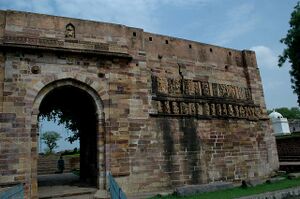Ratnadeva
| Author: Laxman Burdak IFS (R) |
Ratnadeva I (1045-1065 CE) was Kalachuri King of Ratanpur in Bilaspur District, Chhattisgarh. He founded historical place Ratanpur in Bilaspur district in Chhattisgarh. [1]
Variants
Jat Gotras Namesake
History

For some period in Fifth-Sixth Century A.D., Nala kings dominated this area followed by Kalchuri Kings of Tumman who had Ratanpur as their capital.
Ratanpur, originally known as Ratnapura, was the capital of Kalachuris of Ratnapura, who were a branch of the Kalachuris of Tripuri. According to the 1114 CE Ratanpur inscription of the local king Jajjaladeva I, his ancestor Kalingaraja conquered Dakshina Kosala region, and made Tummana (modern Tuman) his capital. Kalingaraja's grandson Ratnaraja established Ratnapura (modern Ratanpur).[2]
Ancestry of Ratanpur Kalachuri rulers
Source - 1. Ratanpur Stone Inscription Of Jajalladeva I - (Kalachuri) Year 866 (=1114 AD)
2. Sarkho Plates of Ratnadeva II - Kalachuri year 880 (1128 AD)
3. Mallar stone inscription of Jajalladeva II (Kalachuri) year 919 (1167 AD)
4. Pendrabandh Plates Of Pratapamalla - (Kalachuri) Year 965 (=1214 AD)
The Ancestry of Ratanpur Kalachuri rulers was as under:
- Kartavirya (Haihayas) →
- Kalingaraja (1000-1020 CE): Kalingaraja who leaving the ancestral country (Tritsu) conquered Dakshina Kosala. He resided at Tummâna as the place was previously the capital of his ancestors. From him was born Kamalaraja →
- Kamalaraja (1020-1045 CE) → Kalingaraja had a son named Kamalaraja, who had a son named Ratnaraja I.
- Ratnadeva I/Ratnaraja I (रत्नराज) (1045-1065 CE): Ratnaraja I adorned Tummâna with several temples, founded Ratanpura and adorned it with many temples. Ratnadeva I married Nônallâ (नोनल्ला) the daughter of Vajjûka (वज्जूक), the lord of the Kômô-mandala. She bore to him a son name Prithvideva I who succeeded him. →
- Prithvideva I (1065-1090 CE): constructed several temples such as that of Prithvishvara at Tummâna and excavated a large tank at Ratanpura. He married Rajalla (राजल्ला) from whom he had a son named Jajalladeva (I).
- Jajalladeva I (1090-1120 CE) → He defeated Someshvara (सोमेश्वर) of Chakrakota. Jajalladeva I founded a town named Jajallapura (जाजल्लपपुर) (modern Janjgir). His son was the illustrious Ratnadeva II.
- Ratnadeva II (1120-1135 CE) (declared independence) : Ratnadeva II, the father of Prithvîdêva II, defeated Chodaganga (चोडगंग) and Gokarna (गोकर्ण) in battle. Ratnadëva II had a son named Prithvideva II]], whose son Jajalladeva II was ruling when the Mallar record was put up.
- Prithvideva II (1135-1165 CE): After Prithvideva II, the Pendrabandh mentions his son Jagaddeva, omitting the name of his brother Jajalladeva II, probably because he was a collateral. Jagaddeva was succeeded by his son Ratnadëva II, whose son Pratapamalla made the present grant
- Jajalladeva II (1165-1168 CE):
- Jagaddeva (1168-1178 CE): After Prithvideva II, the Pendrabandh mentions his son Jagaddeva, omitting the name of his brother Jajalladeva II, probably because he was a collateral. Jagaddeva was succeeded by his son Ratnadeva III, whose son Pratapamalla made the Pendrabandh grant.
- Ratnadeva III (1178-1200 CE): Jagaddeva was succeeded by his son Ratnadeva II, whose son Pratapamalla made the Pendrabandh grant.
- Pratapamalla (1200-1225 CE): Pendrabandh inscription mentions that Pratapamalla gave a village Kâyathâ (कायठा), situated in the Anargha-mandala to a Brahman on the occasion of the Makara-sanktânti. The plates were issued from the victorious camp at Palasadâ (पलसदा) on Tuesday, the 10th day of the bright fortnight of Mâgha in the (Kalachuri) Year 965 (=1214 AD).
External links
References
- ↑ Corpus Inscriptionium Indicarium Vol IV Part 2 Inscriptions of the Kalachuri-Chedi Era, Vasudev Vishnu Mirashi, 1955, p.409-417
- ↑ F. Kielhorn (1888). "Rajim stone inscription of Jagapala of the Kulachuri year 896". The Indian Antiquary: 138.

